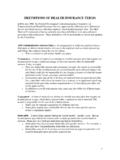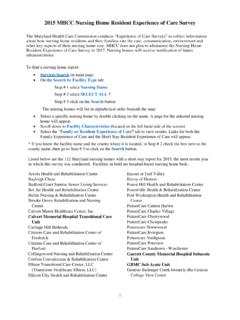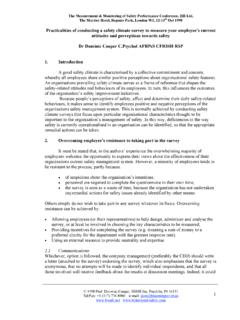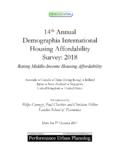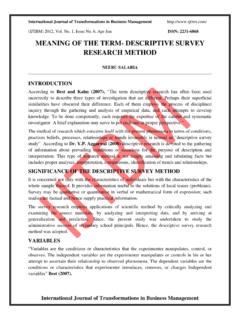Transcription of AMERICAN TIME USE SURVEY—2017 RESULTS
1 For release 10:00 (EDT) Thursday, June 28, 2018 USDL-18-1058. Technical information: (202) 691-6339 Media contact: (202) 691-5902 AMERICAN time USE survey 2017 RESULTS . In 2017, 82 percent of employed persons worked on an average weekday, compared with 33 percent on an average weekend day, the Bureau of Labor Statistics reported today. Multiple jobholders were more likely to work on an average weekend day than were single jobholders 57 percent, compared with 30 percent. These and other RESULTS from the AMERICAN time Use survey (ATUS) were released today. These data include the average amount of time per day in 2017 that individuals worked, did household activities, and engaged in leisure and sports activities. Additionally, measures of the average time per day spent providing childcare both as a primary (or main) activity and while doing other things for the combined years 2013-17 are provided.
2 For a detailed description of ATUS data and methodology, see the Technical Note. Working (by Employed Persons) in 2017. Many more people worked on weekdays than on weekend days: 82 percent of employed persons worked on an average weekday, compared with 33 percent on an average weekend day. (See table 4.). Multiple jobholders were more likely to work on an average weekday than were single jobholders 92 percent, compared with 81 percent. They were also more likely to work on an average weekend day 57 percent, compared with 30 percent. (See table 4.). On the days they worked, 83 percent of employed persons did some or all of their work at their workplace and 23 percent did some or all of their work at home. Employed persons spent more time working at the workplace than at home hours, compared with hours.
3 (See table 6.). Among workers age 25 and over, those with an advanced degree were more likely to work at home than were persons with lower levels of educational attainment 46 percent of those with an advanced degree performed some work at home on days worked, compared with 12 percent of those with a high school diploma. Workers with an advanced degree also were more likely to work on an average day than were those with a high school diploma 73 percent, compared with 68 percent. (See table 6.). On an average day in 2017, 24 percent of full- time employed workers spent some time working while at home. The share of full- time employed workers performing work at home rose from 18. percent per day in 2003 to 24 percent in 2009, and remained relatively flat from 2009 to 2017.
4 (See table 6.). Employed women living with a child under age 6 worked an average of hours per day (about 30 hours per week). They performed 29 minutes per day less work for pay than employed women living in households with older children. (See table 8B.). On the days they worked, employed men worked 49 minutes more than employed women. This difference partly reflects women's greater likelihood of working part time . However, even among full- time workers (those usually working 35 hours or more per week), men worked more per day than women hours, compared with hours. (See table 4.). Household Activities in 2017. On an average day, 84 percent of women and 68 percent of men spent some time doing household activities such as housework, cooking, lawn care, or financial and other household management.
5 (See table 1.). On the days they did household activities, women spent an average of hours on these activities, while men spent hours. (See table 1.). On an average day, 19 percent of men did housework such as cleaning or laundry compared with 49 percent of women. Forty-six percent of men did food preparation or cleanup, compared with 69 percent of women. Men were slightly more likely to engage in lawn and garden care than were women 11 percent, compared with 8 percent. (See table 1.). From 2003 to 2017, the share of men doing food preparation and cleanup on an average day increased from 35 percent to 46 percent. (See table 1.). On average, in households with children under age 6, men spent hours per day less in household activities ( hours) compared with women ( hours).
6 (See table 8A.). Leisure Activities in 2017. On an average day, nearly everyone age 15 and over (96 percent) engaged in some sort of leisure activity, such as watching TV, socializing, or exercising. Men spent 33 minutes per day more in these activities than did women ( hours, compared with hours). (See table 1.). Watching TV was the leisure activity that occupied the most time ( hours per day), accounting for just over half of all leisure time , on average. The amount of time people spent watching TV varied by age. Those ages 15 to 44 spent the least amount of time watching TV, averaging around hours per day, and those ages 65 and over spent the most time watching TV, averaging over hours per day. (See table 11A.). Socializing and communicating, such as visiting with friends or attending or hosting social events, accounted for an average of 39 minutes per day, and was the next most common leisure activity after watching TV.
7 People spent about twice as much time socializing on weekend days (58 minutes) as on weekdays (31 minutes). (See tables 11A and 11B.). -2- time spent reading for personal interest varied greatly by age. Individuals age 75 and over averaged 51 minutes of reading per day whereas individuals ages 15 to 44 read for an average of 10 minutes or less per day. (See table 11A.). On average, individuals ages 15 to 24 spent the most time playing games or using a computer for leisure about one hour per day. Conversely, individuals ages 35 to 44 spent the least amount of time playing games or using a computer for leisure 13 minutes per day. (See table 11A.). Employed adults living in households with no children under age 18 engaged in leisure and sports activities for hours per day, hours more than employed adults living with a child under age 6.
8 (See table 8B.). Care of Household Children for the period 2013-17. Adults living in households with children under age 6 spent an average of hours per day providing primary childcare to household children. Adults living in households where the youngest child was between the ages of 6 and 17 spent less than half as much time providing primary childcare to household children 50 minutes per day. Primary childcare is childcare that is done as a main activity, such as providing physical care or reading to children. (See table 9.). On an average day, among adults living in households with children under age 6, women spent hours providing physical care (such as bathing or feeding a child) to household children; by contrast, men spent 26 minutes providing physical care.
9 (See table 9.). Adults living in households with at least one child under age 6 spent an average of hours per day providing secondary childcare that is, they had at least one child in their care while doing activities other than primary childcare. Secondary childcare provided by adults living in households with children under age 6 was most commonly provided while doing leisure activities ( hours) or household activities ( hours). (See table 10.). Adults living in households with children under age 6 spent more time providing primary childcare on an average weekday ( hours) than on an average weekend day ( hours). However, they spent less time providing secondary childcare on weekdays than on weekend days hours, compared with hours. (See tables 9 and 10.). Additional Data ATUS 2017 data files are available for users to do their own tabulations and analyses.
10 In accordance with BLS and Census Bureau policies that protect the privacy of survey respondents, identifying information does not appear on the data files. The 2017 data files are available on the BLS website at -3- Technical Note The estimates in this news release are based on annual mentioned. After completing the time diary, interviewers ask average data from the AMERICAN time Use survey (ATUS). respondents additional questions to clearly identify work, The ATUS, which is conducted by the Census Bureau volunteering, eldercare, and secondary childcare activities. for the Bureau of Labor Statistics (BLS), is a continuous Secondary childcare is defined as having a child under age survey about how individuals age 15 and over spend their 13 in one's care while doing other activities.


